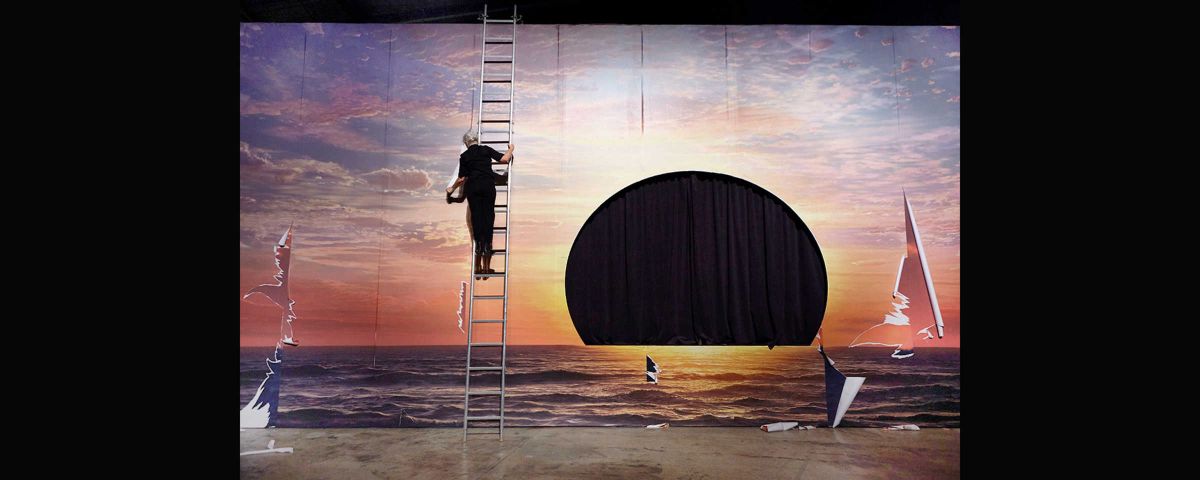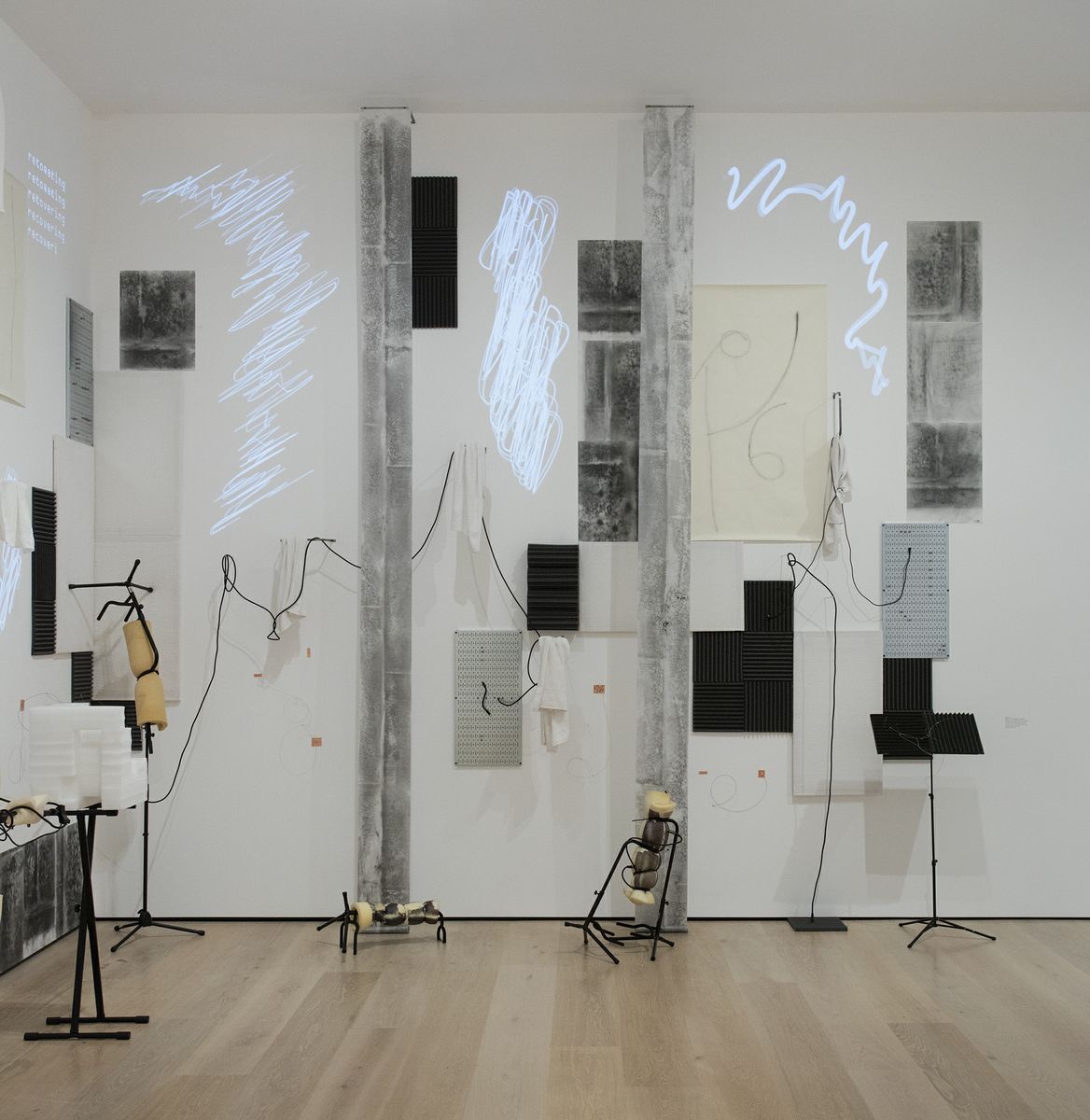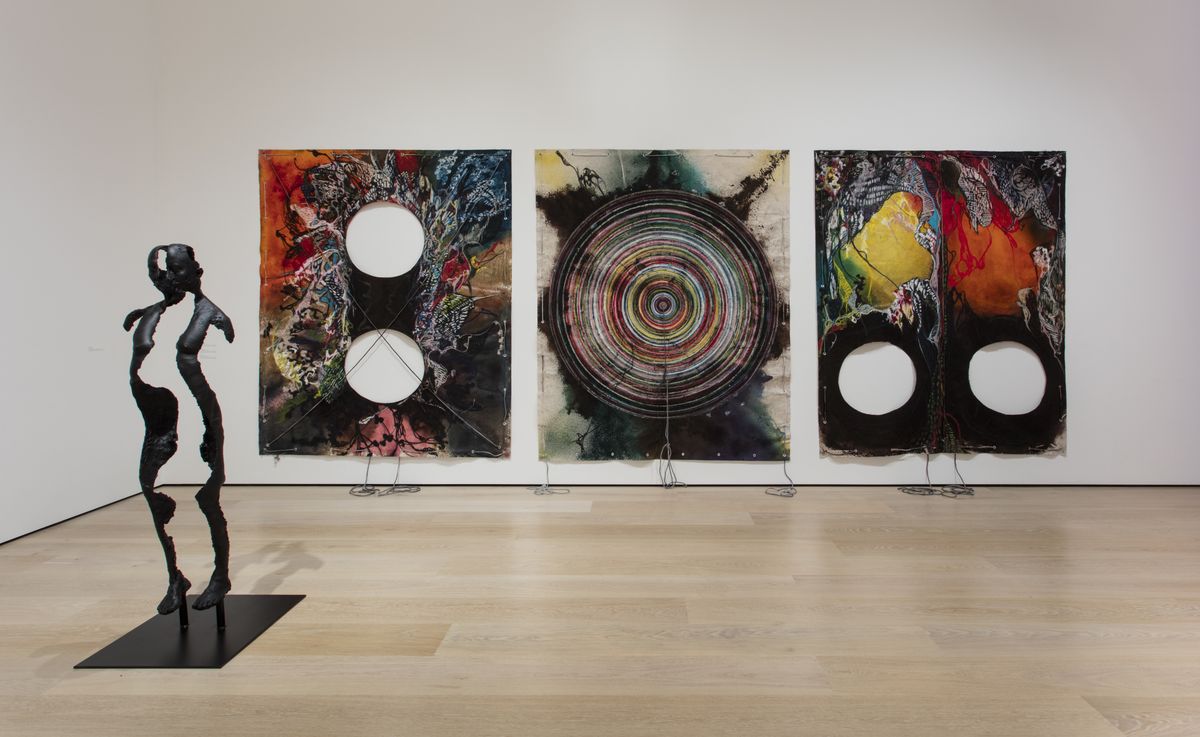The Hammer Museum at UCLA’s “Made in L.A. 2018” has been receiving rave reviews as a showcase for artists from the greater Los Angeles area. Of the 32 artists featured in this year’s exhibition, which is the fourth in the biennial series, 11 are UCLA alumni and 10 of those received their degrees from the UCLA School of the Arts and Architecture.
1. Carmen Argote, 2007 graduate with an M.F.A. in art

Working with materials as diverse as residential carpeting, muslin, coffeemakers, pine needles, and, recently, fiberglass, Carmen Argote contends with class and ideas of home, place and the built environment. Her work is also informed by process, and she frequently leaves vestiges of her actions visible. Argote’s two works in Made in L.A. 2018 illuminate her process while reminding us of the unvarying, as well as the constantly shifting, elements within the urban landscape.
2. Neha Choksi, 1997 graduate with a B.A. in art

Through considerations of consciousness, memory and mortality, Neha Choksi centers her practice on the materialization of time, foregrounding temporality and transformation over the desire for permanence. Choksi’s work — in which performance-based video is primary, but which also includes photography, sculptures and works on paper — explores the fragility of life, how we process loss and the productive possibilities in confronting, head-on, manifestations of absence. For “Made in L.A. 2018,” Choksi created the multichannel video installation “Everything sunbright,” which is the culmination of a series of works examining our relationship to the sun, divided into birth, life struggle, and death.
3. Mercedes Dorame, 2003 graduate with a B.A. in American literature and culture
Mercedes Dorame uses photography to explore, reimagine and connect to her Gabrielino-Tongva tribal culture and bring visibility to contemporary indigenous experience. The Tongva were the first people in what is now Los Angeles, with territory covering the expanse from Malibu to San Bernardino to Aliso Creek. Although they have inhabited the L.A. basin for more than 8,000 years and are officially recognized as an indigenous tribe by the state of California, they are not recognized federally, meaning that they have limited access to federal funding and no designated reservation land. For “Made in L.A. 2018,” Dorame intertwined two bodies of photography and created a sculptural installation working with organic materials and original artifacts.
4. Nikita Gale, 2016 graduate with an M.F.A. in art

Nikita Gale’s practice explores the idea of interpersonal relationships and how consumer products and technology-driven objects contribute to the evolution of these exchanges. She employs these objects in installations and sculptures to heighten their presence, relieve them of their societal functionality and reveal their inner workings. Through this explicit handling, Gale also considers the term reproduction as a bridge to understanding how both biological and mechanical repetition work together as agents of transformation. For “Made in L.A. 2018,” Gale constructed a sprawling installation that considers protest and the history of rock and roll as a sonic foundation.
5. EJ Hill, 2013 graduate with an M.F.A. in art
At the core of EJ Hill’s practice is a form of durational performance that reflects both the hardships that certain bodies are forced to endure and the enormous resilience of those bodies. Hill insists that we look at how our society’s deeply held prejudices and inequalities continue to render black, brown and queer bodies the targets of violence, and his work can be as painful to contend with as it is essential to witness. Yet he believes in the power of representation and the possibility of healing. Through an expansive practice, Hill remains committed to making visible, to retelling the story, and to affirming experience. For “Made in L.A. 2018,” Hill uses performance to explore how we can re-engage with institutions that have shaped us and purge experiences of feeling insignificant in order to imagine how those places might become more inclusive.
6. Naotaka Hiro, 1997 graduate with a B.A. in art

During the past two decades, Naotaka Hiro has grappled with the question of whether we can ever know the parts of our bodies that we are unable to see without the aid of a mirror or camera. Much of his work — which encompasses a range of media, including drawing, painting, sculpture, and video — stretches his body’s capabilities to their very limits to document and comprehend these unknowable spaces. For “Made in L.A. 2018,” he presents a series of paintings and a sculptural installation with which he subjects himself to processes that test his endurance and the limits of his physical form in an effort to explore “the dilemma of the unknowability of my body.”
7. John Houck, 2007 graduate with an M.F.A. in design media arts

John Houck’s photographs are an amalgam of folds, creases, grids, and painted passages, all layered to collage-like effect. Each photograph is the result of a process whereby the artist composes, layers, photographs, prints, and re-photographs numerous times, intentionally leaving the seams and edges visible. While his work addresses some of the intrinsic characteristics of photography — the manipulation of light and shadow, varying or skewed perspectives, optics and the illusion of depth — he is also invested in photography’s unique ability to conjure the past, reminding us of the ways in which photographs are useful tools for remembering, exploring and understanding our complex inner lives. For “Made in L.A. 2018,” Houck presents three photographs from his “Playing and Reality” series and two new diptychs from Houck’s ongoing “Accumulator” series.
8. Eamon Ore-Giron, 2006 graduate with an M.F.A. in art
Eamon Ore-Giron’s mural, “Angelitos Negros,” extends across the museum’s walls, filling them with his characteristic abstract forms. Ore-Giron renders combinations of elemental shapes — circles, triangles, rectangles, and squares — in bright colors with luminous interlocking and overlapping passages. The artist draws his distinct visual vocabulary from geographically diverse sources that extend from the present to the ancient past. “Angelitos Negros” is inspired by the poem “Píntame angelitos negros (Paint me little black angels),” written by the Venezuelan poet and politician, Andrés Eloy Blanco, in 1943. In it, the poet implores “the painter” to include angelitos negros, or black angels, in his religious works. The poem, which was adapted into a song in 1950, is a commentary on racial discrimination, written during the height of World War II. This lamentation on exclusion and erasure offers a poignant commentary on the long history and impact of colonialism in the Americas.
9. taisha paggett, 2008 graduate with an M.F.A. in world arts and cultures/dance
taisha paggett is a dance artist whose individual and collaborative interdisciplinary works re-articulate and collide specific Western choreographic practices with the politics of daily life. Her movement-based practice often examines fixed notions of queer black embodiment and survival. Her works include the dance company project WXPT (we are the paper, we are the trees) and the collaborative School for the Movement of the Technicolor People, both of which seek to radicalize concepts held within contemporary dance by way of an intersection with social practice; critical pedagogy; somatic and contemplative investigations; queer, feminist and black studies; performance and visual art studies; and the political and philosophical meshes of personal history. For “Made in L.A. 2018,” paggett and WXPT collaborator Meena Murugesan expand upon an ongoing piece called counts orchestrate, a meadow (or weekly practice with breath).
Performances:
Sunday, June 17, 3 p.m.
Sunday, July 8, noon to 4 p.m.
Saturday, Sept. 1, noon to 4 p.m.
10. Michael Queenland, 2002 graduate with an M.F.A. in art

Working across photography and sculpture, Michael Queenland examines the relationships between images, objects and language. Often utilizing found objects that he has accumulated, altered or translated into another material, the artist blurs the boundaries between artifacts and art. For “Made in L.A. 2018,” Queenland revisits the highly processed cereals that were part of a 2012 site-specific sculptural installation titled “Rudy’s Ramp of Remainders.” For “Cereals for space migration,” the bags of grains are stripped of their cardboard boxes and inserted into metal mesh containers whose transparency serves to highlight their artificial shapes and preternatural colors. Queenland links our estranged relationship to agriculture and the ingredients that make up many of our foods to a shared anxiety about survival, pressing us to consider how notions of progress can distance us from our origins, languages, customs and identities.
11. Flora Wiegmann, 2007 graduate with an M.F.A. in world arts and cultures/dance

Dancer and choreographer Flora Wiegmann looks for the spaces of intersection between the visual arts and performance. For nearly 15 years, she has located her movement-based practice within the context of visual arts institutions and public sites, such as parks and beaches, rather than the proscenium or theater. Her projects are often structured within a precise conceptual framework, which might be instigated by a site, a specific historical reference or a current event. For “Made in L.A. 2018,” Wiegmann has created a new piece, “Reduction Burn,” in response to a sense of vulnerability that seems to be permeating all aspects of our lives today. The artist considers California’s recent wildfires as a destructive force and as a metaphor for upheaval and entropy in other arenas, such as politics, and for incidents in her personal life related to aging and illness.
Performances:
Sunday, June 17, 2 p.m.
Friday, June 22, 7 p.m.
Sunday, July 15, 2:30 p.m. and 4 p.m.
Wednesday, Aug. 22, 7 p.m
“Made in L.A. 2018” is organized by Anne Ellegood, senior curator, and Erin Christovale, assistant curator, with MacKenzie Stevens, curatorial associate. Performances are coordinated by Vanessa Arizmendi, curatorial assistant.




